TNCC 9TH EDITION – 2024 Study guides, Class notes & Summaries
Looking for the best study guides, study notes and summaries about TNCC 9TH EDITION – 2024? On this page you'll find 5 study documents about TNCC 9TH EDITION – 2024.
All 5 results
Sort by
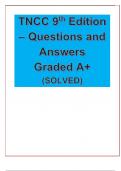
-
TNCC 9TH EDITION – QUESTIONS AND ANSWERS GRADED A+ (SOLVED 2023/2024)
- Exam (elaborations) • 11 pages • 2024
-
- $10.99
- + learn more
1. An adult patient who sustained a severe head trauma has been intubated and is being manually ventilated via a bag-mask device at a rate of 18 breaths/minute. The patient has receive one intravenous fluid bolus 500 mL of warmed isotonic crystalloid solution. The PaCO2 is 30 mm Hg (4.0 kPa), and the pulse oximetry is 92%. BP is 142/70 mm Hg. What is the most important intervention to manage the cerebral blood flow? A. Decrease the rate of manual ventilation.*** B. Initiate another fluid bol...
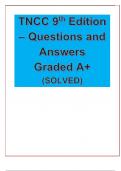
-
TNCC 9TH EDITION – QUESTIONS AND ANSWERS GRADED A+ (SOLVED 2023/2024)
- Exam (elaborations) • 11 pages • 2024
-
- $11.39
- + learn more
1. An adult patient who sustained a severe head trauma has been intubated and is being manually ventilated via a bag-mask device at a rate of 18 breaths/minute. The patient has receive one intravenous fluid bolus 500 mL of warmed isotonic crystalloid solution. The PaCO2 is 30 mm Hg (4.0 kPa), and the pulse oximetry is 92%. BP is 142/70 mm Hg. What is the most important intervention to manage the cerebral blood flow? A. Decrease the rate of manual ventilation.*** B. Initiate another fluid bol...
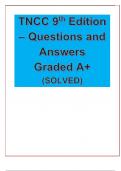
-
TNCC 9TH EDITION – QUESTIONS AND ANSWERS GRADED A+ (SOLVED 2023/2024)
- Exam (elaborations) • 11 pages • 2024
-
- $11.39
- + learn more
1. An adult patient who sustained a severe head trauma has been intubated and is being manually ventilated via a bag-mask device at a rate of 18 breaths/minute. The patient has receive one intravenous fluid bolus 500 mL of warmed isotonic crystalloid solution. The PaCO2 is 30 mm Hg (4.0 kPa), and the pulse oximetry is 92%. BP is 142/70 mm Hg. What is the most important intervention to manage the cerebral blood flow? A. Decrease the rate of manual ventilation.*** B. Initiate another fluid bol...
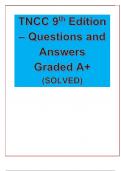
-
TNCC 9TH EDITION – QUESTIONS AND ANSWERS GRADED A+ (SOLVED 2023/2024)
- Exam (elaborations) • 11 pages • 2024
-
- $10.99
- + learn more
1. An adult patient who sustained a severe head trauma has been intubated and is being manually ventilated via a bag-mask device at a rate of 18 breaths/minute. The patient has receive one intravenous fluid bolus 500 mL of warmed isotonic crystalloid solution. The PaCO2 is 30 mm Hg (4.0 kPa), and the pulse oximetry is 92%. BP is 142/70 mm Hg. What is the most important intervention to manage the cerebral blood flow? A. Decrease the rate of manual ventilation.*** B. Initiate another fluid bol...
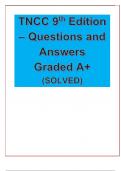
-
TNCC 9TH EDITION – QUESTIONS AND ANSWERS GRADED A+ (SOLVED 2023/2024)
- Exam (elaborations) • 11 pages • 2024
-
- $10.99
- + learn more
1. An adult patient who sustained a severe head trauma has been intubated and is being manually ventilated via a bag-mask device at a rate of 18 breaths/minute. The patient has receive one intravenous fluid bolus 500 mL of warmed isotonic crystalloid solution. The PaCO2 is 30 mm Hg (4.0 kPa), and the pulse oximetry is 92%. BP is 142/70 mm Hg. What is the most important intervention to manage the cerebral blood flow? A. Decrease the rate of manual ventilation.*** B. Initiate another fluid bol...

How much did you already spend on Stuvia? Imagine there are plenty more of you out there paying for study notes, but this time YOU are the seller. Ka-ching! Discover all about earning on Stuvia


